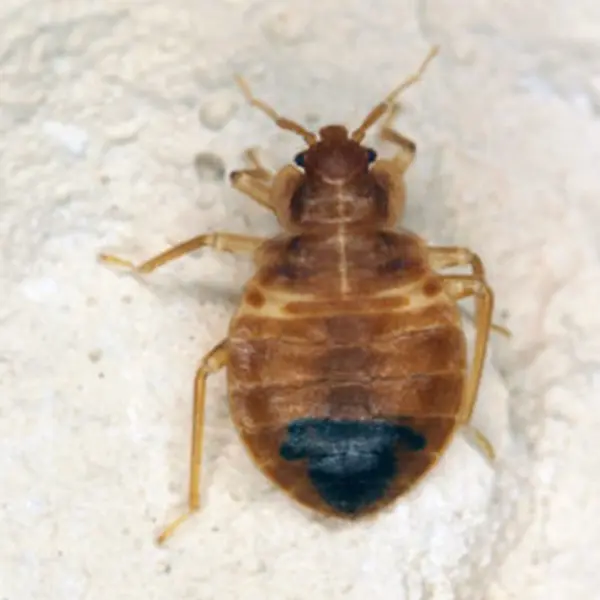Bed Bug Identification
Found throughout all 50 states, bed bugs are nocturnal insects that feed exclusively on blood. Humans serve as their primary host, but they also feed on birds and mammals. Bed bugs are secretive and remain well hidden in cracks and crevices located in places where they are not likely to be disturbed. Bed bugs typically feed at night while their host lay fast asleep, and they can live for a year or longer without a blood meal. Their bite is essentially painless, so they are rarely detected at the time of feeding activity.
What Do Bed Bugs Look Like?
Bed bugs are small, reddish-brown insects that feed on the blood of animals or humans. They have flat bodies, about the size of an apple seed, and can swell up and become redder after a blood meal. Adult bed bugs have oval-shaped bodies with six legs, while the nymphs (young bedbugs) are smaller and translucent or whitish-yellow in color.
Signs of a Bed Bug Infestation
The first sign of a bed bug infestation may be the appearance of bites on the skin or the appearance of small brownish dots on the bed, as bed bugs leave behind specks of fecal matter on mattresses, sheets, or nearby furniture. Look out for small bloodstains on your sheets or mattress, which result from accidentally crushing bed bugs after they’ve fed. Bed bugs also shed their skins as they grow, so you might find these translucent shells in areas where bed bugs hide.
Habitat, Diet, Life Cycle & Bites
Where Do Bed bugs Live?
Bed bugs live in groups and inhabit areas where humans sleep or rest for extended periods of time. Bed bugs are usually transported, unknowingly, from place to place as people travel. They conceal themselves in the seams and folds of luggage, overnight bags, bedding, furniture, and anywhere they can hide. Bed bugs can be found in homes, hotels, apartment buildings, schools, medical facilities, and other areas frequented by the public. These pests favor cracks, crevices, or seams in headboards, mattresses, luggage, backpacks, and upholstered furniture.
Diet of Bed Bugs
Bed bugs feed exclusively on blood, typically at night when their hosts are asleep. While they prefer human blood, they can also feed on other warm-blooded animals if necessary.
Life Cycle of Bed Bugs
The life cycle of a bed bug consists of several stages: egg, nymph, and adult. Under favorable conditions, bed bugs can mature from eggs to adults in about a month. They require a blood meal at each stage of their development.
Bed Bug Bites
Bed bug bites often appear in a line or cluster on the skin and can cause itching, redness and swelling. Their bites can vary in appearance and may not cause immediate pain. However, not everyone reacts to bed bug bites, so it’s essential to look for other signs as well.
Are Bed Bugs Dangerous?
Bed bugs do not spread disease and are not considered dangerous; however, an allergic reaction to several bites may need medical attention. Additionally, dealing with a bed bug infestation can be stressful and disruptive to your daily life. It’s essential to address infestations promptly to prevent them from spreading and causing further issues.
How to Get Rid of Bed bugs?
Dealing with a bed bug infestation requires a comprehensive approach as this tiny and persistent pest can be extremely tricky to treat without the help of a professional pest control company. You can help keep them away by regularly vacuuming, cleaning and decluttering to eliminate hiding spots. If you find evidence of a bed bug infestation, wash bedding, linens and clothing in very hot water and dry them on a high heat to kill any bed bugs present.
If you need help with a bed bug infestation, call our expert team of professional bed bug exterminators to help evict them for good!
Bed Bug Prevention Tips
Preventing bed bug infestations is key to keeping them away from your home or business. Be cautious when travelling and staying in hotels or other accommodation to avoid picking up any unwanted hitchhikers. Check the rooms for signs of bed bugs including the bloodstains and dark spots on the mattress and aim to store your luggage on a raised wrack or stand to avoid laying it on the carpet.
Use protective covers on your mattresses and furniture and try to reduce clutter to remove any potential hiding spots. Finally seal cracks in walls, baseboards and furniture to prevent bed bugs entering your property.
Need help with Bed Bugs control?
FAQ’S
What are the early signs of bed bugs?
Early signs of bed bugs include: Itchy bites in a clustered or linear pattern, bloodstains on sheets or pillowcases, dark spots or specks (fecal matter) on bedding or furniture and shed skins or eggshells in areas where bed bugs hide.
What is the main cause for bed bugs?
Bed bugs are typically introduced into a home through infested furniture, luggage, or clothing. They can also migrate from neighboring infested dwellings through cracks and crevices.
What brings bed bugs into the house?
Bed bugs are attracted to warmth, carbon dioxide, and the scent of human blood. They are often brought into the house through infested furniture, luggage, or clothing, or they can migrate from nearby infested dwellings.
Where do bed bugs hide on your body?
Bed bugs typically do not remain on your body for extended periods. They prefer to hide in cracks and crevices near their host’s sleeping area, such as in mattresses, box springs, bed frames, or nearby furniture. However, they may occasionally feed on exposed skin while their host is asleep.

